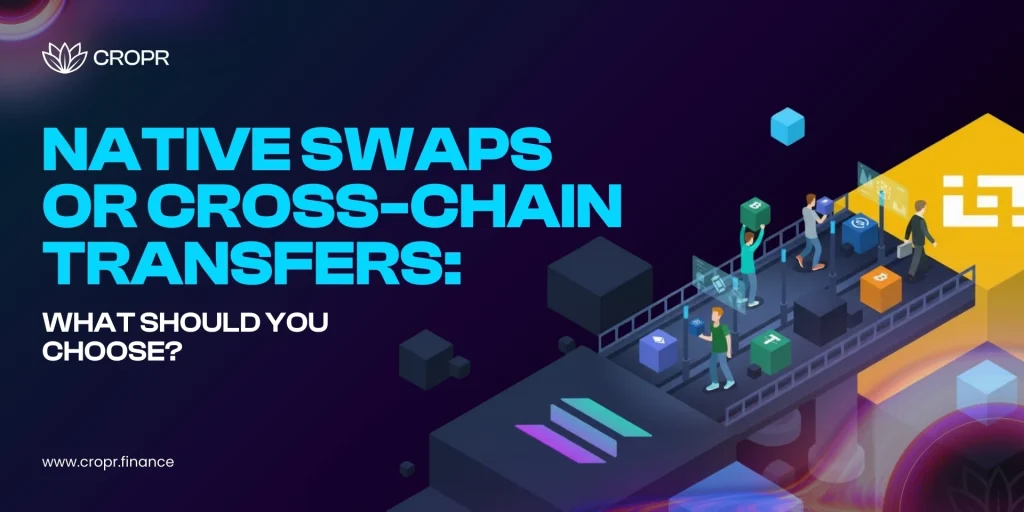The crypto market has matured to a point where traders and investors are no longer limited to one chain. Assets now move between Ethereum, Arbitrum, Optimism, Polygon, and countless others. With this expansion comes a common question: Should you use a native swap or a cross-chain bridge when moving funds?
The answer isn’t as simple as picking one method and sticking with it. Each has strengths, risks, and trade-offs. If you’re serious about crypto portfolio management or looking to optimize your DeFi portfolio management, understanding the difference matters more than ever.
What do native swaps and bridges actually mean?
A native swap usually happens on a decentralized exchange (DEX) like Uniswap or Curve. You’re swapping one token for another on the same blockchain. The mechanics are familiar: liquidity pools, automated market makers, and the concept of slippage when your order slightly shifts the price.
A cross-chain bridge, on the other hand, is designed to move your assets from one blockchain to another. For example, sending USDC from Ethereum to Arbitrum. You’re not just swapping; you’re transferring value between two systems with different consensus and execution rules.
In vs Swap: Where confusion starts
Many newcomers see “swap” and think it’s always the same thing. But in vs swap is an important distinction. Swapping in the same chain ensures straightforward execution and finality. Swapping via a bridge introduces extra steps, such as locking assets on one side and minting representations on the other.
This is why people often debate native swap vs bridge as if they are interchangeable. They’re not. A bridge is about transferring across networks, while a swap is about changing token exposure within a network.
The cost question: Slippage vs Bridge fees
Every trader wants the best route for crypto transfer, but the cost calculus isn’t always obvious.
- In a native swap, your main concern is slippage. If liquidity is thin, your trade might execute at a worse rate than expected.
- In a cross-chain bridge, you face bridge fees plus potential delays. Fees vary depending on the bridge provider and the underlying chain. Sometimes the cost is flat, sometimes it depends on the transaction size.
Here’s the interesting part: sometimes a bridge is cheaper, especially if liquidity is better on the destination chain. Other times, staying on the same chain and swapping locally makes more sense.
Execution vs Finality: Why timing matters?
When you swap natively, execution is near-instant, and finality is tied to the block confirmation of that chain. With bridges, things can get tricky. Some bridges promise “fast finality,” but what they really mean is that you’re trusting their relayers or validators to confirm the transfer. The actual underlying chain finality might take longer.
For example, bridging ETH from the Ethereum mainnet to Polygon could take minutes, while a simple swap on Ethereum takes seconds. That’s the execution vs finality trade-off you need to keep in mind, especially when speed is critical.
Security and Risk Tolerance
Security is the elephant in the room. Bridges have historically been the target of some of the largest exploits in DeFi history. Billions have been lost due to smart contract vulnerabilities or validator collusion.
Native swaps aren’t immune to risks either, but their attack surface is usually smaller. Liquidity pool exploits exist, but DEXs with battle-tested contracts tend to be safer than new or unproven bridges.
So, should you avoid bridges altogether? Not necessarily. If your strategy requires cross-chain exposure, a bridge is unavoidable. The key is to pick the most reputable and audited bridge solutions rather than chasing the absolute lowest fee.
When should you use a native swap?
- When you only need to change tokens within the same chain.
- When you want minimal delay and straightforward finality.
- When liquidity is deep enough to reduce slippage.
A native swap is often best for active traders, especially those using on-chain tools like a crypto portfolio manager that require quick adjustments.
When does a cross-chain bridge make sense?
- When your DeFi strategy spans multiple chains.
- When fees are significantly lower on the destination chain.
- When specific opportunities, such as yield farms or lending markets, exist only on another blockchain.
Here’s the thing: if you’re serious about defi portfolio management, you’ll eventually need to bridge. The question is not if but how and when.
The Balancing Act
Choosing between swaps and bridges isn’t a one-time decision. It’s situational. You weigh slippage vs bridge fees, execution vs finality, and risk vs opportunity.
Think of it like traveling. Sometimes it’s easier to take a direct route in the same city. Other times, you have to catch a flight to another country. Both involve trade-offs, and both serve a purpose.
Final Thoughts
The choice between a native swap and a cross-chain transfer is not about picking a winner; it’s about finding the best solution for your needs. It depends on your goal, the chain you’re working with, and the trade-offs you’re willing to accept. Swaps offer speed, simplicity, and lower risk, while bridges open access to opportunities that live beyond a single chain, though they require extra caution and cost awareness.
For anyone serious about crypto portfolio management or improving their defi portfolio management, the real skill lies in knowing when each tool makes sense. Switch on one day to avoid slippage and bridge the next day to chase lower fees or higher yields. That balance is where more brilliant execution happens.
At CROPR, we make that decision-making easier. Our platform compares routes, highlights slippage vs bridge fees, and gives you clarity on execution vs finality before you commit.
Try out our demo now and experience a more informed way to manage your crypto transfers.

